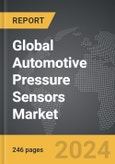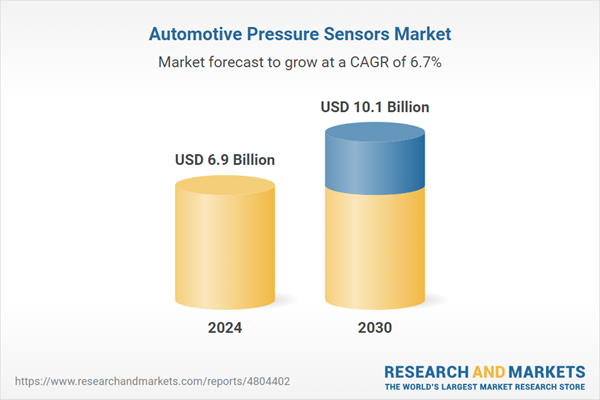The global market for Automotive Pressure Sensors was valued at US$6.9 Billion in 2024 and is projected to reach US$10.1 Billion by 2030, growing at a CAGR of 6.7% from 2024 to 2030. This comprehensive report provides an in-depth analysis of market trends, drivers, and forecasts, helping you make informed business decisions.
Global Automotive Pressure Sensors Market - Key Trends and Drivers Summarized
How Do Automotive Pressure Sensors Ensure Optimal Vehicle Performance?
Automotive pressure sensors have become an essential component in modern vehicles, providing critical data to maintain safety, efficiency, and overall performance. These sensors are responsible for monitoring various pressure levels in different vehicle systems, such as the engine, tires, brakes, and exhaust. By delivering real-time information to the vehicle's electronic control unit (ECU), they enable precise adjustments that ensure optimal functionality. For example, tire pressure sensors help prevent blowouts and improve fuel efficiency by alerting drivers when the tire pressure is too low. In the engine, pressure sensors play a vital role in fine-tuning fuel injection, leading to better combustion and reduced emissions. As automotive systems grow increasingly complex, the importance of these sensors continues to rise, making them indispensable in today's vehicles.What Role Do Technological Innovations Play in Enhancing Automotive Pressure Sensors?
Technological advancements are revolutionizing automotive pressure sensors, making them more accurate, reliable, and versatile than ever before. The integration of Microelectromechanical Systems (MEMS) technology is a key development, allowing sensors to be miniaturized without losing their effectiveness. MEMS pressure sensors are highly valued for their precision, low power consumption, and ability to fit into tight spaces within automotive systems. The advent of wireless and IoT technologies has further enhanced these sensors, enabling real-time data transmission to cloud platforms for advanced diagnostics and predictive maintenance. These innovations are not only improving vehicle safety and performance but are also setting the stage for new applications in connected and autonomous vehicles, where precise and reliable pressure monitoring is crucial.What Challenges and Opportunities Are Shaping the Future of Automotive Pressure Sensors?
The automotive pressure sensor market faces several challenges, yet these challenges also present significant opportunities for innovation and growth. One major challenge is the need for sensors to endure harsh operating conditions, such as extreme temperatures, vibrations, and corrosive environments. This has led to advancements in sensor materials and designs, including the use of protective coatings and encapsulation techniques. Another challenge is ensuring that sensors maintain their accuracy over the long lifespan of a vehicle, driving the development of self-calibrating sensors and advanced signal processing algorithms. On the opportunity front, the growing demand for electric and autonomous vehicles is creating a surge in the need for sophisticated pressure sensors, particularly in areas like battery management, cooling systems, and adaptive cruise control. These trends are fueling the expansion of the pressure sensor market, with manufacturers investing heavily in R&D to meet the evolving demands of the automotive industry.What's Driving the Growth in the Automotive Pressure Sensor Market?
The growth in the automotive pressure sensor market is driven by several factors, including the widespread adoption of advanced driver assistance systems (ADAS), the transition to electric and hybrid vehicles, and the tightening of safety and emissions regulations. As ADAS technologies like lane-keeping assist, adaptive cruise control, and automated braking become standard, the need for precise pressure sensors to manage these systems is increasing. The shift towards electric and hybrid vehicles is also contributing to market growth, as these vehicles require specialized sensors for battery management, cooling, and braking systems. Additionally, stricter global regulations on emissions and safety are making pressure sensors a critical component for compliance, particularly in engines, exhaust systems, and tires. Consumer demand for vehicles that offer enhanced safety, efficiency, and performance is further accelerating the adoption of advanced pressure sensors, positioning the market for continued expansion as the automotive industry evolves.Report Scope
The report analyzes the Automotive Pressure Sensors market, presented in terms of market value (US$ Thousand). The analysis covers the key segments and geographic regions outlined below.Segments
Application (Engine Control System, ABS, Airbags, Power Steering, Direct TPMS, HVAC, Transmission); End-Use (Passenger Cars, Commercial Vehicles).Geographic Regions/Countries
World; United States; Canada; Japan; China; Europe (France; Germany; Italy; United Kingdom; Spain; Russia; and Rest of Europe); Asia-Pacific (Australia; India; South Korea; and Rest of Asia-Pacific); Latin America (Argentina; Brazil; Mexico; and Rest of Latin America); Middle East (Iran; Israel; Saudi Arabia; United Arab Emirates; and Rest of Middle East); and Africa.Key Insights:
- Market Growth: Understand the significant growth trajectory of the Engine Control System Application segment, which is expected to reach US$3.3 Billion by 2030 with a CAGR of a 6.9%. The ABS Application segment is also set to grow at 7.2% CAGR over the analysis period.
- Regional Analysis: Gain insights into the U.S. market, valued at $1.8 Billion in 2024, and China, forecasted to grow at an impressive 10.8% CAGR to reach $2.3 Billion by 2030. Discover growth trends in other key regions, including Japan, Canada, Germany, and the Asia-Pacific.
Report Features:
- Comprehensive Market Data: Independent analysis of annual sales and market forecasts in US$ Million from 2024 to 2030.
- In-Depth Regional Analysis: Detailed insights into key markets, including the U.S., China, Japan, Canada, Europe, Asia-Pacific, Latin America, Middle East, and Africa.
- Company Profiles: Coverage of major players such as Continental AG, CS INSTRUMENTS GmbH & Co. KG, ES Systems, Euro Car Parts Limited, First Sensor AG and more.
- Complimentary Updates: Receive free report updates for one year to keep you informed of the latest market developments.
Why You Should Buy This Report:
- Detailed Market Analysis: Access a thorough analysis of the Global Automotive Pressure Sensors Market, covering all major geographic regions and market segments.
- Competitive Insights: Get an overview of the competitive landscape, including the market presence of major players across different geographies.
- Future Trends and Drivers: Understand the key trends and drivers shaping the future of the Global Automotive Pressure Sensors Market.
- Actionable Insights: Benefit from actionable insights that can help you identify new revenue opportunities and make strategic business decisions.
Key Questions Answered:
- How is the Global Automotive Pressure Sensors Market expected to evolve by 2030?
- What are the main drivers and restraints affecting the market?
- Which market segments will grow the most over the forecast period?
- How will market shares for different regions and segments change by 2030?
- Who are the leading players in the market, and what are their prospects?
Some of the 46 major companies featured in this Automotive Pressure Sensors market report include:
- Continental AG
- CS INSTRUMENTS GmbH & Co. KG
- ES Systems
- Euro Car Parts Limited
- First Sensor AG
- Imasen Electric Industrial Co., Ltd.
- Kita Sensor Tech Company Limited
- Makersan Makina Otomotiv San. Tic. A.S.
- MVD Auto Components Pvt., Ltd.
- Nidec Copal Electronics Corporation
Table of Contents
I. METHODOLOGYII. EXECUTIVE SUMMARY2. FOCUS ON SELECT PLAYERSIII. MARKET ANALYSISCANADAITALYSPAINRUSSIAREST OF EUROPESOUTH KOREAREST OF ASIA-PACIFICARGENTINABRAZILMEXICOREST OF LATIN AMERICAIRANISRAELSAUDI ARABIAUNITED ARAB EMIRATESREST OF MIDDLE EASTIV. COMPETITION
1. MARKET OVERVIEW
3. MARKET TRENDS & DRIVERS
4. GLOBAL MARKET PERSPECTIVE
UNITED STATES
JAPAN
CHINA
EUROPE
FRANCE
GERMANY
UNITED KINGDOM
ASIA-PACIFIC
AUSTRALIA
INDIA
LATIN AMERICA
MIDDLE EAST
AFRICA
Companies Mentioned (Partial List)
A selection of companies mentioned in this report includes, but is not limited to:
- Continental AG
- CS INSTRUMENTS GmbH & Co. KG
- ES Systems
- Euro Car Parts Limited
- First Sensor AG
- Imasen Electric Industrial Co., Ltd.
- Kita Sensor Tech Company Limited
- Makersan Makina Otomotiv San. Tic. A.S.
- MVD Auto Components Pvt., Ltd.
- Nidec Copal Electronics Corporation
Table Information
| Report Attribute | Details |
|---|---|
| No. of Pages | 246 |
| Published | April 2025 |
| Forecast Period | 2024 - 2030 |
| Estimated Market Value ( USD | $ 6.9 Billion |
| Forecasted Market Value ( USD | $ 10.1 Billion |
| Compound Annual Growth Rate | 6.7% |
| Regions Covered | Global |









